Exogenous Melatonin Enhances the Yield and Secondary Metabolite Contents of Prunella vulgaris by Modulating Antioxidant System, Root Architecture and Photosynthetic Capacity
Abstract
:1. Introduction
2. Results
2.1. Antioxidant Enzyme Activity and Osmoregulation Substance Content
2.2. REC and the Contents of MDA and H2O2
2.3. The Contents of Chlorophyll and Carotenoid
2.4. Gas Exchange Parameters
2.5. Root Architecture
2.6. Chlorophyll Fluorescence OJIP Curve and 820 nm Modulated Reflection
2.7. Fast Chlorophyll Fluorescence Parameters of P. vulgaris
2.8. The Function and Coordination of PSII and PSI
2.9. Dry Mass of Whole Plant and Spica
2.10. Secondary Metabolite Contents
3. Discussion
4. Materials and Methods
4.1. Plant Materials
4.2. Experimental Design
4.3. Determination of Antioxidant Enzyme Activity
4.4. Determination of Soluble Sugar Content
4.5. Determination of Photosynthetic Pigment
4.6. Determination of Proline Content
4.7. Measurement of Malondialdehyde Content
4.8. Determination of Relative Electrical Conductivity
4.9. Determination of Hydrogen Peroxide Content
4.10. Root Morphology
4.11. Determination of Dry Mass
4.12. Determination of Gas Exchange Parameters
4.13. Fast Chlorophyll Fluorescence and 820 nm Modulated Reflection
4.14. Determination of Total Phenolic Content
4.15. Determination of Total Flavonoids Content
4.16. Caffeic Acid, Ferulic Acid, Rosmarinic Acid, and Hyperoside Contents
4.17. Statistical Analysis
5. Conclusions
Author Contributions
Funding
Data Availability Statement
Conflicts of Interest
References
- Chen, Y.H.; Yu, M.M.; Zhu, Z.B.; Zhang, L.X.; Guo, Q.S. Optimisation of potassium chloride nutrition for proper growth, physiological development and bioactive component production in Prunella vulgaris L. PLoS ONE 2013, 8, e66259. [Google Scholar]
- Chen, Y.H.; Liu, L.; Guo, Q.S.; Zhu, Z.B.; Zhang, L.X. Effects of different water management options and fertilizer supply on photosynthesis, fluorescence parameters and water use efficiency of Prunella vulgaris seedlings. Biol. Res. 2016, 49, 12. [Google Scholar] [CrossRef] [Green Version]
- Bai, Y.B.; Xia, B.H.; Xie, W.J.; Zhou, Y.M.; Xie, J.C.; Li, H.Q.; Liao, D.F.; Lin, L.M.; Li, C. Phytochemistry and pharmacological activities of the genus Prunella. Food Chem. 2016, 204, 483–496. [Google Scholar]
- Chen, Y.H.; Zhang, X.R.; Guo, Q.S.; Cao, L.P.; Qin, Q.; Li, C.; Zhao, M.; Wang, W.M. Plant morphology, physiological characteristics, accumulation of secondary metabolites and antioxidant activities of Prunella vulgaris L. under UV solar exclusion. Biol. Res. 2019, 52, 17. [Google Scholar] [PubMed] [Green Version]
- Lv, L. Protective Effect and Mechanism of Rosmarinik Acid on Acute Liver Injury Induced by APAP in Mice. Bachelor’s Thesis, Guangxi University, Nanning, China, 2020. [Google Scholar]
- Zhang, L.X.; Chang, Q.S.; Hou, X.G.; Wang, J.Z.; Chen, S.D.; Zhang, Q.M.; Wang, Z.; Yin, Y.; Liu, J.K. The effect of high-temperature stress on the physiological indexes, chloroplast ultrastructure, and photosystems of two herbaceous peony cultivars. J. Plant Growth Regul. 2022. [Google Scholar] [CrossRef]
- Hasanuzzaman, M.; Bhuyan, M.H.M.B.; Zulfiqar, F.; Raza, A.; Mohsin, S.M.; Mahmud, J.A.; Fujita, M.; Fotopoulos, V. Reactive oxygen species and antioxidant defense in plants under abiotic stress: Revisiting the crucial role of a universal defense regulator. Antioxidants 2020, 9, 681. [Google Scholar] [CrossRef] [PubMed]
- Coskun, Y.; Duran, R.E.; Kilic, S. Striking effects of melatonin on secondary metabolites produced by callus culture of rosemary (Rosmarinus officinalis L.). Plant Cell Tissue Org. 2019, 138, 89–95. [Google Scholar] [CrossRef]
- Qin, B.; Zou, J.N.; Cao, L.; Wang, M.Y.; Zhang, Y.X. Melatonin regulates material transport to reduce carbon emissions and increase yield under different nitrogen in rice. Agric. Ecosyst. Environ. 2023, 342, 108235. [Google Scholar] [CrossRef]
- Altaf, M.A.; Shahid, R.; Ren, M.X.; Mora, P.F.; Arnao, M.B.; Naz, S.; Anwar, M.; Altaf, M.M.; Shahid, S.; Shakoor, A.; et al. Phytomelatonin: An overview of the importance and mediating functions of melatonin against environmental stresses. Physiol. Plantarum. 2021, 172, 820–846. [Google Scholar] [CrossRef]
- Sun, C.L.; Liu, L.J.; Wang, L.X.; Li, B.H.; Jin, C.W.; Lin, X.Y. Melatonin: A master regulator of plant development and stress responses. J. Integr. Plant Biol. 2021, 63, 126–145. [Google Scholar] [CrossRef]
- Xu, L.L.; Yue, Q.Y.; Bian, F.E.; Sun, H.; Zhai, H.; Yao, Y.X. Melatonin enhances phenolics accumulation partially via ethylene signaling and resulted in high antioxidant capacity in grape berries. Front. Plant Sci. 2017, 8, 1426. [Google Scholar]
- Iqbal, R.; Khan, T. Application of exogenous melatonin in vitro and in planta: A review of its effects and mechanisms of action. Biotechnol. Lett. 2022, 44, 933–950. [Google Scholar]
- Guo, Y.Y.; Li, H.J.; Liu, J.; Bai, Y.W.; Xue, J.Q.; Zhang, R.H. Melatonin alleviates drought-induced damage of photosynthetic apparatus in maize seedlings. Russ. J. Plant Physiol. 2020, 67, 312–322. [Google Scholar] [CrossRef]
- Ahmad, S.; Cui, W.; Kamran, M.; Ahmad, I.; Meng, X.P.; Wu, X.R.; Su, W.; Javed, T.; El-Serehy, H.A.; Jia, Z.K.; et al. Exogenous application of melatonin induces tolerance to salt stress by improving the photosynthetic efficiency and antioxidant defense system of maize seedling. J. Plant Growth Regul. 2020, 40, 1270–1283. [Google Scholar] [CrossRef]
- Malik, Z.; Afzal, S.; Dawood, M.; Abbasi, G.H.; Khan, M.I.; Kamran, M.; Zhran, M.; Hayat, M.T.; Aslam, M.N.; Rafay, M. Exogenous melatonin mitigates chromium toxicity in maize seedlings by modulating antioxidant system and suppresses chromium uptake and oxidative stress. Environ. Geochem. Health 2021, 44, 1451–1469. [Google Scholar] [CrossRef]
- Fazal, H.; Abbasi, B.H.; Ahmad, N.; Ali, M. Exogenous melatonin trigger biomass accumulation and production of stress enzymes during callogenesis in medicinally important Prunella vulgaris L. (Selfheal). Physiol. Mol. Biol. Plants 2018, 24, 1307–1315. [Google Scholar] [CrossRef]
- Jafari, M.; Shahsavar, A. The effect of foliar application of melatonin on changes in secondary metabolite contents in two citrus species under drought stress conditions. Front. Plant Sci. 2021, 12, 692735. [Google Scholar]
- Yang, L.; You, J.; Li, J.Z.; Wang, Y.P.; Chan, Z.L.; Sunkar, R. Melatonin promotes Arabidopsis primary root growth in an IAA-dependent manner. J. Exp. Bot. 2021, 72, 5599–5611. [Google Scholar]
- Wang, Q.N.; An, B.; Wei, Y.X.; Reiter, R.J.; Shi, H.T.; Luo, H.L.; He, C.Z. Melatonin regulates root meristem by repressing auxin synthesis and polar auxin transport in Arabidopsis. Front. Plant Sci. 2016, 7, 1882. [Google Scholar] [CrossRef] [Green Version]
- Yang, X.X.; Chen, J.; Ma, Y.; Huang, M.H.; Qiu, T.; Bian, H.W.; Han, N.; Wang, J.H. Function, mechanism, and application of plant melatonin: An update with a focus on the cereal crop, barley (Hordeum vulgare L.). Antioxidants 2022, 11, 634. [Google Scholar] [CrossRef] [PubMed]
- Wei, J.; Li, D.X.; Zhang, J.R.; Shan, C.; Rengel, Z.; Song, Z.B.; Chen, Q. Phytomelatonin receptor PMTR1-mediated signaling regulates stomatal closure in Arabidopsis thaliana. J. Pineal Res. 2018, 65, e12500. [Google Scholar] [CrossRef]
- Wang, L.; Li, T.; Zhang, Y.; Guo, J.; Lu, K.; Liu, W. CAND2/PMTR1 Is Required for Melatonin-Conferred Osmotic Stress Tolerance in Arabidopsis. Int. J. Mol. Sci. 2021, 22, 4014. [Google Scholar] [CrossRef]
- Jin, G.P.; Liu, F.; Ma, H.; Hao, S.Y.; Zhao, Q.; Bian, Z.R.; Jia, Z.H.; Song, S.S. Two G-protein-coupled-receptor candidates, Cand2 and Cand7, are involved in Arabidopsis root growth mediated by the bacterial quorum-sensing signals N-acyl-homoserine lactones. Biochem. Biophys. Res. Commun. 2012, 417, 991–995. [Google Scholar] [CrossRef] [PubMed]
- Duan, W.J.; Lu, B.; Liu, L.T.; Meng, Y.J.; Ma, X.Y.; Li, J.; Zhang, K.; Sun, H.C.; Zhang, Y.J.; Dong, H.Z.; et al. Effects of exogenous melatonin on root physiology, transcriptome and metabolome of cotton seedlings under salt stress. Int. J. Mol. Sci. 2022, 23, 9456. [Google Scholar] [CrossRef]
- Zhang, N.; Zhang, H.J.; Zhao, B.; Sun, Q.Q.; Cao, Y.Y.; Li, R.; Wu, X.X.; Weeda, S.; Li, L.; Ren, S.; et al. The RNA-seq approach to discriminate gene expression profiles in response to melatonin on cucumber lateral root formation. J. Pineal Res. 2014, 56, 39–50. [Google Scholar]
- Altaf, M.A.; Shahid, R.; Ren, M.X.; Khan, L.U.; Altaf, M.M.; Jahan, M.S.; Nawaz, M.A.; Naz, S.; Shahid, S.; Lal, M.K.; et al. Protective mechanisms of melatonin against vanadium phytotoxicity in tomato seedlings: Insights into nutritional status, photosynthesis, root architecture system, and antioxidant machinery. J. Plant Growth Regul. 2022, 41, 3300–3316. [Google Scholar] [CrossRef]
- Xie, J.; Qin, Z.Y.; Pan, J.L.; Li, J.; Li, X.; Khoo, H.E.; Dong, X.H. Melatonin treatment improves postharvest quality and regulates reactive oxygen species metabolism in “Feizixiao” litchi based on principal component analysis. Front. Plant Sci. 2022, 13, 965345. [Google Scholar] [PubMed]
- Li, Y.T.; Xu, W.W.; Ren, B.Z.; Zhao, B.; Zhang, J.; Liu, P.; Zhang, Z.S. High temperature reduces photosynthesis in maize leaves by damaging chloroplast ultrastructure and photosystem II. J. Agron. Crop Sci. 2020, 206, 548–564. [Google Scholar] [CrossRef]
- Cruz, J.A.; Avenson, T.J. Photosynthesis: A multiscopic view. J. Plant Res. 2021, 134, 665–682. [Google Scholar]
- Varghese, N.; Alyammahi, O.; Nasreddine, S.; Alhassani, A.; Gururani, M.A. Melatonin positively influences the photosynthetic machinery and antioxidant system of avena sativa during salinity stress. Plants 2019, 8, 610. [Google Scholar] [CrossRef] [Green Version]
- Yin, Z.P.; Lu, J.Z.; Meng, S.D.; Liu, Y.L.; Mostafa, I.; Qi, M.F.; Li, T.L. Exogenous melatonin improves salt tolerance in tomato by regulating photosynthetic electron flux and the ascorbate-glutathione cycle. J. Plant Interact. 2019, 14, 453–463. [Google Scholar] [CrossRef] [Green Version]
- Wu, P.; Ma, Y.D.; Ahammed, G.J.; Hao, B.Y.; Chen, J.Y.; Wan, W.L.; Zhao, Y.H.; Cui, H.M.; Xu, W.; Cui, J.X.; et al. Insights into melatonin-induced photosynthetic electron transport under low-temperature stress in cucumber. Front. Plant Sci. 2022, 13, 1029854. [Google Scholar] [CrossRef] [PubMed]
- Zhang, J.; Shi, Y.; Zhang, X.Z.; Du, H.M.; Xu, B.; Huang, B.R. Melatonin suppression of heat-induced leaf senescence involves changes in abscisic acid and cytokinin biosynthesis and signaling pathways in perennial ryegrass (Lolium perenne L.). Environ. Exp. Bot. 2017, 138, 36–45. [Google Scholar] [CrossRef]
- Weeda, S.; Zhang, N.; Zhao, X.; Ndip, G.; Guo, Y.; Buck, G.A.; Fu, C.; Ren, S. Arabidopsis transcriptome analysis reveals key roles of melatonin in plant defense systems. PLoS ONE 2014, 9, e93462. [Google Scholar] [CrossRef] [Green Version]
- Hwang, O.J.; Back, K. Melatonin is involved in skotomorphogenesis by regulating brassinosteroid biosynthesis in rice plants. J. Pineal Res. 2018, 65, e12495. [Google Scholar] [CrossRef]
- Bistgani, Z.E.; Hashemi, M.; Dacosta, M.; Craker, L.; Maggi, F.; Morshedloo, M.R. Effect of salinity stress on the physiological characteristics, phenolic compounds and antioxidant activity of Thymus vulgaris L. and Thymus daenensis Celak. Ind. Crop. Prod. 2019, 135, 311–320. [Google Scholar] [CrossRef]
- Asif, M.; Pervez, A.; Ahmad, R. Role of melatonin and plant-growth-promoting rhizobacteria in the growth and development of plants. Clean-Soil Air Water 2019, 47, 1800459. [Google Scholar] [CrossRef]
- Qi, J.S.; Song, C.P.; Wang, B.S.; Zhou, J.M.; Kangasjarvi, J.; Zhu, J.K.; Gong, Z.Z. Reactive oxygen species signaling and stomatal movement in plant responses to drought stress and pathogen attack. J. Integr. Plant Biol. 2018, 60, 805–826. [Google Scholar] [CrossRef] [Green Version]
- Lee, M.W.; Huffaker, A.; Crippen, D.; Robbins, R.T.; Goggin, F.L. Plant elicitor peptides promote plant defences against nematodes in soybean. Mol. Plant Pathol. 2018, 19, 858–869. [Google Scholar] [CrossRef] [Green Version]
- Gill, S.S.; Tuteja, N. Reactive oxygen species and antioxidant machinery in abiotic stress tolerance in crop plants. Plant Physiol. Biochem. 2010, 48, 909–930. [Google Scholar] [CrossRef]
- Debnath, B.; Islam, W.; Li, M.; Sun, Y.; Lu, X.; Mitra, S.; Hussain, M.; Liu, S.; Qiu, D. Melatonin mediates enhancement of stress tolerance in plants. Int. J. Mol. Sci. 2019, 20, 1040. [Google Scholar] [CrossRef] [Green Version]
- Elsayed, A.I.; Rafudeen, M.S.; Gomaa, A.M.; Hasanuzzaman, M. Exogenous melatonin enhances the reactive oxygen species metabolism, antioxidant defense-related gene expression, and photosynthetic capacity of Phaseolus vulgaris L. to confer salt stress tolerance. Physiol. Plant. 2021, 173, 1369–1381. [Google Scholar] [CrossRef]
- Mir, A.R.; Siddiqui, H.; Alam, P.; Hayat, S. Melatonin modulates photosynthesis, redox status, and elemental composition to promote growth of Brassica juncea-a dose-dependent effect. Protoplasma 2020, 257, 1685–1700. [Google Scholar] [CrossRef] [PubMed]
- Li, J.; Liu, Y.; Zhang, M.; Xu, H.; Ning, K.; Wang, B.; Chen, M. Melatonin increases growth and salt tolerance of Limonium bicolor by improving photosynthetic and antioxidant capacity. BMC Plant Biol. 2022, 22, 16. [Google Scholar] [CrossRef]
- Sheikhalipour, M.; Mohammadi, S.A.; Esmaielpour, B.; Zareei, E.; Kulak, M.; Ali, S.; Nouraein, M.; Bahrami, M.K.; Gohari, G.; Fotopoulos, V. Exogenous melatonin increases salt tolerance in bitter melon by regulating ionic balance, antioxidant system and secondary metabolism-related genes. BMC Plant Biol. 2022, 22, 380. [Google Scholar] [CrossRef] [PubMed]
- Keunen, E.; Peshev, D.; Vangronsveld, J.; Van Den Ende, W.; Cuypers, A. Plant sugars are crucial players in the oxidative challenge during abiotic stress: Extending the traditional concept. Plant Cell Environ. 2013, 36, 1242–1255. [Google Scholar] [CrossRef]
- Liu, L.; Wang, Z.Y.; Gai, Z.J.; Wang, Y.B.; Wang, B.; Zhang, P.F.; Liu, X.Y.; Chen, J.T.; Zhang, S.Y.; Liu, D.; et al. Exogenous application of melatonin improves salt tolerance of sugar beet (Beta vulgaris L.) seedlings. Acta Physiol. Plant. 2022, 44, 1–15. [Google Scholar] [CrossRef]
- Yang, N.; Han, M.H.; Teng, R.M.; Yang, Y.Z.; Wang, Y.H.; Xiong, A.S.; Zhuang, J. Exogenous melatonin enhances photosynthetic capacity and related gene expression in a dose-dependent manner in the tea plant (Camellia sinensis (L.) Kuntze). Int. J. Mol. Sci. 2022, 23, 6694. [Google Scholar] [CrossRef]
- Kurt-Celebi, A.; Colak, N.; Torun, H.; Dosedelova, V.; Tarkowski, P.; Ayaz, F.A. Exogenous melatonin ameliorates ionizing radiation-induced damage by modulating growth, osmotic adjustment and photosynthetic capacity in wheat seedlings. Plant Physiol. Biochem. 2022, 187, 67–76. [Google Scholar] [CrossRef] [PubMed]
- Han, Q.H.; Huang, B.; Ding, C.B.; Zhang, Z.W.; Chen, Y.E.; Hu, C.; Zhou, L.J.; Huang, Y.; Liao, J.Q.; Yuan, S.; et al. Effects of melatonin on anti-oxidative systems and photosystem II in cold-stressed rice seedlings. Front. Plant Sci. 2017, 8, 785. [Google Scholar] [CrossRef]
- Dogru, A. Effects of heat stress on photosystem II activity and antioxidant enzymes in two maize cultivars. Planta 2021, 253, 85. [Google Scholar] [CrossRef] [PubMed]
- Danilova, E.D.; Efimova, M.V.; Kolomeichuk, L.V.; Kuznetsov, V.V. Melatonin supports photochemical activity of assimilation apparatus and delays senescence of leaves of monocotyledonous plants. Dokl. Biochem. Biophys. 2020, 495, 271–275. [Google Scholar] [CrossRef] [PubMed]
- Harrison, E.L.; Arce Cubas, L.; Gray, J.E.; Hepworth, C. The influence of stomatal morphology and distribution on photosynthetic gas exchange. Plant J. 2020, 101, 768–779. [Google Scholar] [CrossRef] [PubMed] [Green Version]
- Zhou, K.; Li, Y.T.; Hu, L.Y.; Zhang, J.Y.; Yue, H.; Yang, S.L.; Liu, Y.; Gong, X.Q.; Ma, F.W. Overexpression of MdASMT9, an N-acetylserotonin methyltransferase gene, increases melatonin biosynthesis and improves water-use efficiency in transgenic apple. Tree Physiol. 2022, 42, 1114–1126. [Google Scholar] [CrossRef] [PubMed]
- Guo, H.; York, L.M. Maize with fewer nodal roots allocates mass to more lateral and deep roots that improve nitrogen uptake and shoot growth. J. Exp. Bot. 2019, 70, 5299–5309. [Google Scholar] [CrossRef]
- Ma, Z.; Baskin, T.I.; Brown, K.M.; Lynch, J.P. Regulation of root elongation under phosphorus stress involves changes in ethylene responsiveness. Plant Physiol. 2003, 131, 1381–1390. [Google Scholar] [CrossRef] [Green Version]
- Sarropoulou, V.; Dimassi-Theriou, K.; Therios, I.; Koukourikou-Petridou, M. Melatonin enhances root regeneration, photosynthetic pigments, biomass, total carbohydrates and proline content in the cherry rootstock PHL-C (Prunus avium × Prunus cerasus). Plant Physiol. Biochem. 2012, 61, 162–168. [Google Scholar] [CrossRef]
- Mir, A.R.; Faizan, M.; Bajguz, A.; Sami, F.; Siddiqui, H.; Hayat, S. Occurrence and biosynthesis of melatonin and its exogenous effect on plants. Acta Soc. Bot. Pol. 2020, 89, 1–23. [Google Scholar] [CrossRef]
- Meftahizadeh, H.; Baath, G.S.; Saini, R.K.; Falakian, M.; Hatami, M. Melatonin-mediated alleviation of soil salinity stress by modulation of redox reactions and phytochemical status in guar (Cyamopsis tetragonoloba L.). J. Plant Growth Regul. 2022. [Google Scholar] [CrossRef]
- Zhang, Z.S.; Liu, M.J.; Scheibe, R.; Selinski, J.; Zhang, L.T.; Yang, C.; Meng, X.L.; Gao, H.Y. Contribution of the alternative respiratory pathway to psii photoprotection in C3 and C4 plants. Mol. Plant. 2017, 10, 131–142. [Google Scholar] [CrossRef] [Green Version]
- Chalanika De Silva, H.C.; Asaeda, T. Effects of heat stress on growth, photosynthetic pigments, oxidative damage and competitive capacity of three submerged macrophytes. J. Plant Interact. 2017, 12, 228–236. [Google Scholar] [CrossRef] [Green Version]
- Yang, H.; Zhang, J.T.; Zhang, H.W.; Xu, Y.; An, Y.Y.; Wang, L.J. Effect of 5-Aminolevulinic acid (5-ALA) on leaf chlorophyll fast fluorescence characteristics and mineral element content of Buxus megistophylla grown along urban roadsides. Horticulturae 2021, 7, 95. [Google Scholar] [CrossRef]
- Lazar, D.; Murch, S.J.; Beilby, M.J.; Al Khazaaly, S. Exogenous melatonin affects photosynthesis in characeae Chara australis. Plant Signal. Behav. 2013, 8, e23279. [Google Scholar] [CrossRef] [PubMed] [Green Version]
- Strasser, R.J.; Tsimilli-Michael, M.; Qiang, S.; Goltsev, V. Simultaneous in vivo recording of prompt and delayed fluorescence and 820-nm reflection changes during drying and after rehydration of the resurrection plant Haberlea rhodopensis. BBA-Bioenergetics 2010, 1797, 1313–1326. [Google Scholar] [CrossRef] [Green Version]
- Chen, Z.C.; Jin, X.J.; Li, H.; Zhou, W.X.; Qiang, B.B.; Liu, J.; Zhang, Y.X. Effects of exogenous melatonin on growth, photosynthetic fluorescence characteristics and yield components of adzuki bean. Crops 2021, 37, 88–94. [Google Scholar]
- Zhang, L.X.; Chang, Q.S.; Hou, X.G.; Chen, S.D.; Zhang, Q.M.; Wang, J.Z.; Liu, S.S.; Li, S. Biochemical and photosystem characteristics of wild-type and Chl b-deficient mutant in tree peony (Paeonia suffruticosa). Photosynthetica 2021, 59, 256–265. [Google Scholar] [CrossRef]
- Liang, D.; Shen, Y.Q.; Ni, Z.Y.; Wang, Q.; Lei, Z.; Xu, N.Q.; Deng, Q.X.; Lin, L.J.; Wang, J.; Lv, X.L.; et al. Exogenous melatonin application delays senescence of kiwifruit leaves by regulating the antioxidant capacity and biosynthesis of flavonoids. Front. Plant Sci. 2018, 9, 426. [Google Scholar] [CrossRef]
- Wang, X.M.; Liao, W.N.; Chen, J.; Wu, Y.D.; Liu, C.N.; Chen, S.L.; Xu, Y.; Wang, S.; Su, Y.P.; Du, C.H.; et al. Caffeic acid attenuates irradiation-induced hematopoietic stem cell apoptosis through inhibiting mitochondrial damage. Exp. Cell Res. 2021, 409, 112934. [Google Scholar] [CrossRef]
- Zhang, L.B.; Lv, J.L. A new ferulic acid derivative and other anticoagulant compounds from Angelica sinensis. Chem. Nat. Compd. 2018, 54, 13–17. [Google Scholar] [CrossRef]
- Vafadar, F.; Amooaghaie, R.; Ehsanzadeh, P.; Ghanadian, M.; Talebi, M.; Ghanati, F. Melatonin and calcium modulate the production of rosmarinic acid, luteolin, and apigenin in Dracocephalum kotschyi under salinity stress. Phytochemistry 2020, 177, 112422. [Google Scholar] [CrossRef]
- Duran, R.E.; Kilic, S.; Coskun, Y. Melatonin influence on in vitro callus induction and phenolic compound production in sweet basil (Ocimum basilicum L.). In Vitro Cell Dev.-An. 2019, 55, 468–475. [Google Scholar] [CrossRef]
- Li, X.N.; Brestic, M.; Tan, D.X.; Zivcak, M.; Zhu, X.C.; Liu, S.Q.; Song, F.B.; Reiter, R.J.; Liu, F.L. Melatonin alleviates low PS I-limited carbon assimilation under elevated CO2 and enhances the cold tolerance of offspring in chlorophyll b-deficient mutant wheat. J. Pineal Res. 2018, 64, e12453. [Google Scholar] [CrossRef]
- Li, Y.; Liang, W.; Zhao, B. Physiological and microstructural responses of two Rhododendron cultivars to high temperature and low light. Hortic. Environ. Biotechnol. 2020, 61, 445–458. [Google Scholar] [CrossRef]
- Dong, F.; Wang, C.Z.; Sun, X.D.; Bao, Z.L.; Dong, C.; Sun, C.H.; Ren, Y.Q.; Liu, S.Q. Sugar metabolic changes in protein expression associated with different light quality combinations in tomato fruit. Plant Growth Regul. 2019, 88, 267–282. [Google Scholar] [CrossRef]
- Lichtenthaler, H.K. Chlorophylls and carotenoids: Pigments of photosynthetic biomembranes. Method Enzymol. 1987, 148, 350–382. [Google Scholar]
- Bates, L.S.; Waldren, R.P.; Teare, I.D. Rapid determination of free proline for water-stress studies. Plant Soil 1973, 39, 205–207. [Google Scholar] [CrossRef]
- Cai, H.L.; Xie, P.F.; Zeng, W.A.; Zhai, Z.G.; Zhou, W.; Tang, Z. Root-specific expression of rice OsHMA3 reduces shoot cadmium accumulation in transgenic tobacco. Mol. Breed. 2019, 39, 49. [Google Scholar] [CrossRef]
- Alexieva, V.; Sergiev, I.; Mapelli, S.; Karanov, E. The effect of drought and ultraviolet radiation on growth and stress markers in pea and wheat. Plant Cell Environ. 2001, 24, 1337–1344. [Google Scholar] [CrossRef]
- Zhang, Z.S.; Jia, Y.J.; Gao, H.Y.; Zhang, L.T.; Li, H.D.; Meng, Q.W. Characterization of PSI recovery after chilling-induced photoinhibition in cucumber (Cucumis Sativus L.). Planta 2011, 234, 883–889. [Google Scholar] [CrossRef]
- Zhu, M.; Zhan, J.L.; Gao, Z.Y.; Fan, J.F.; Zhao, E.L. Study on ultrasonic-assisted extraction and antioxidant activities of polyphone from Prunella vulgaris L. China Food Addit. 2018, 12, 136–142. [Google Scholar] [CrossRef]
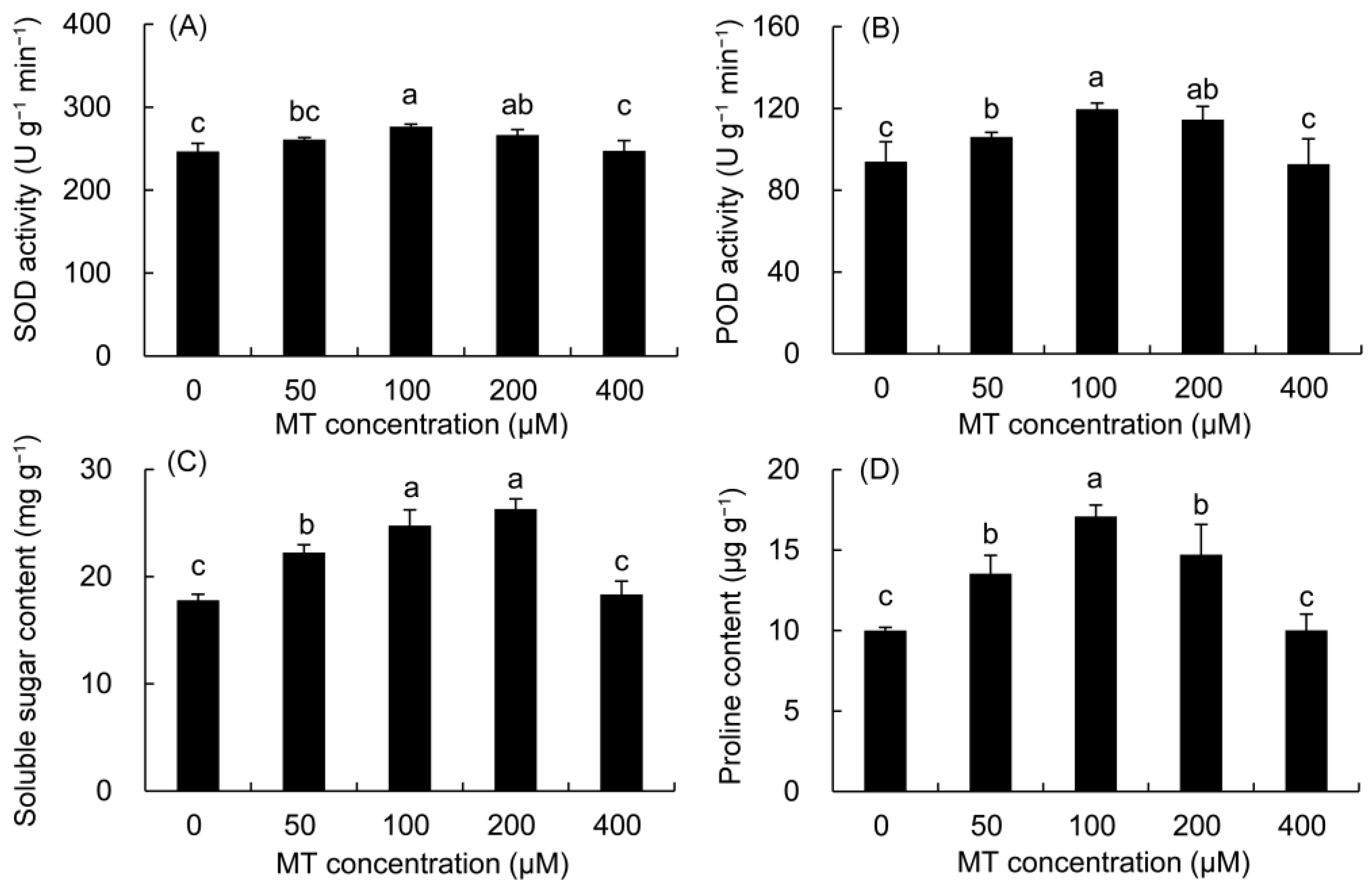

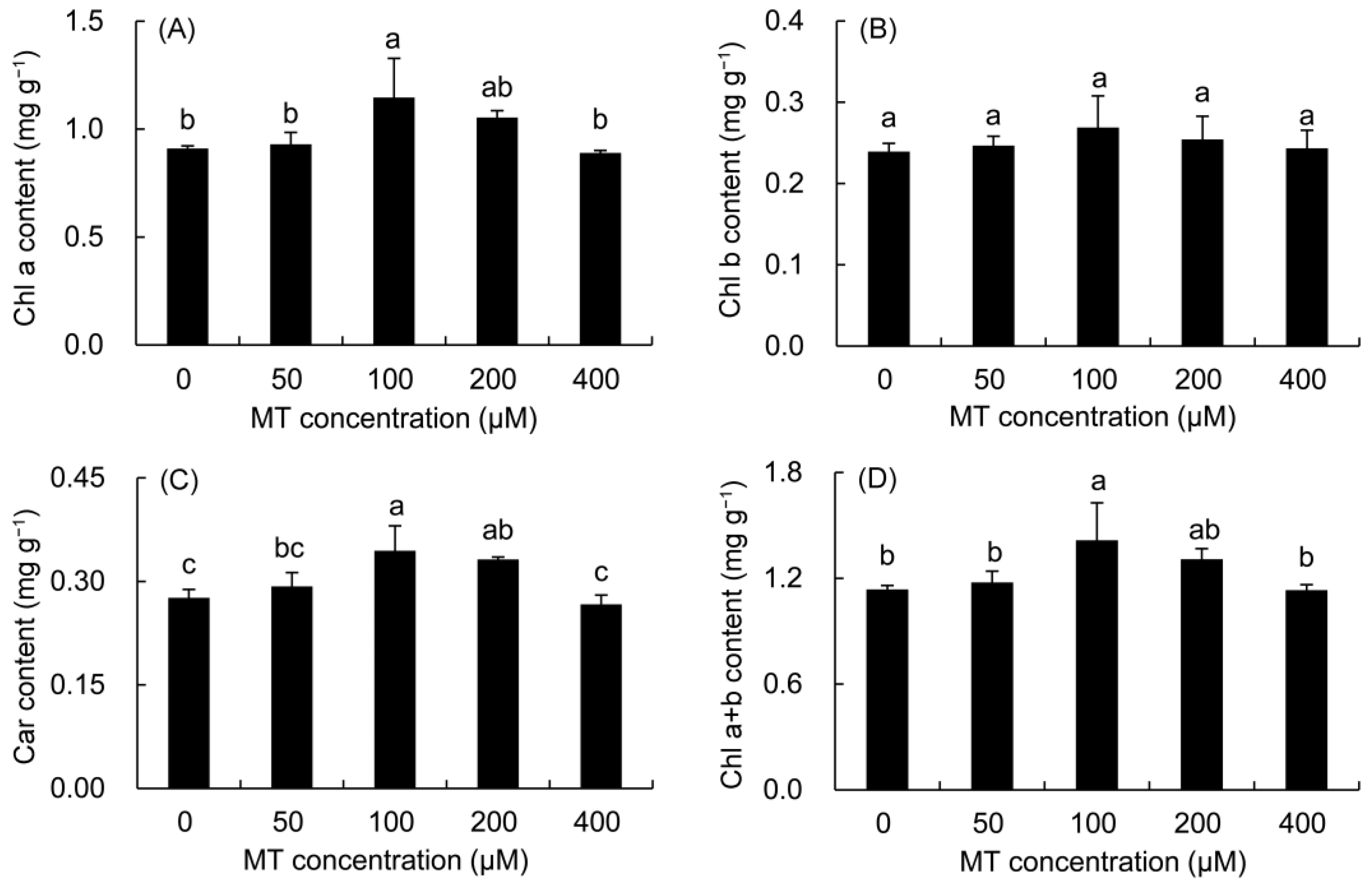
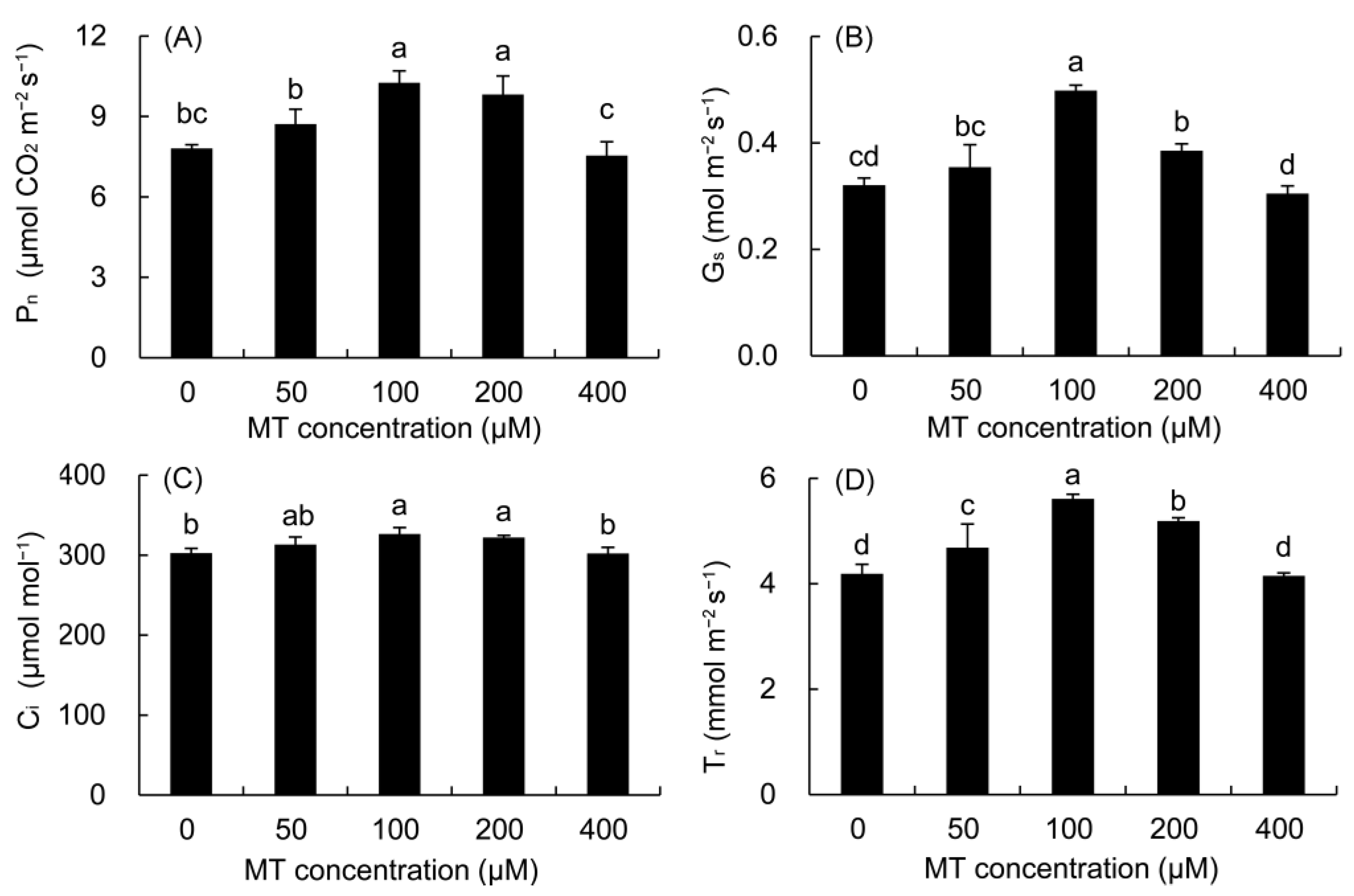
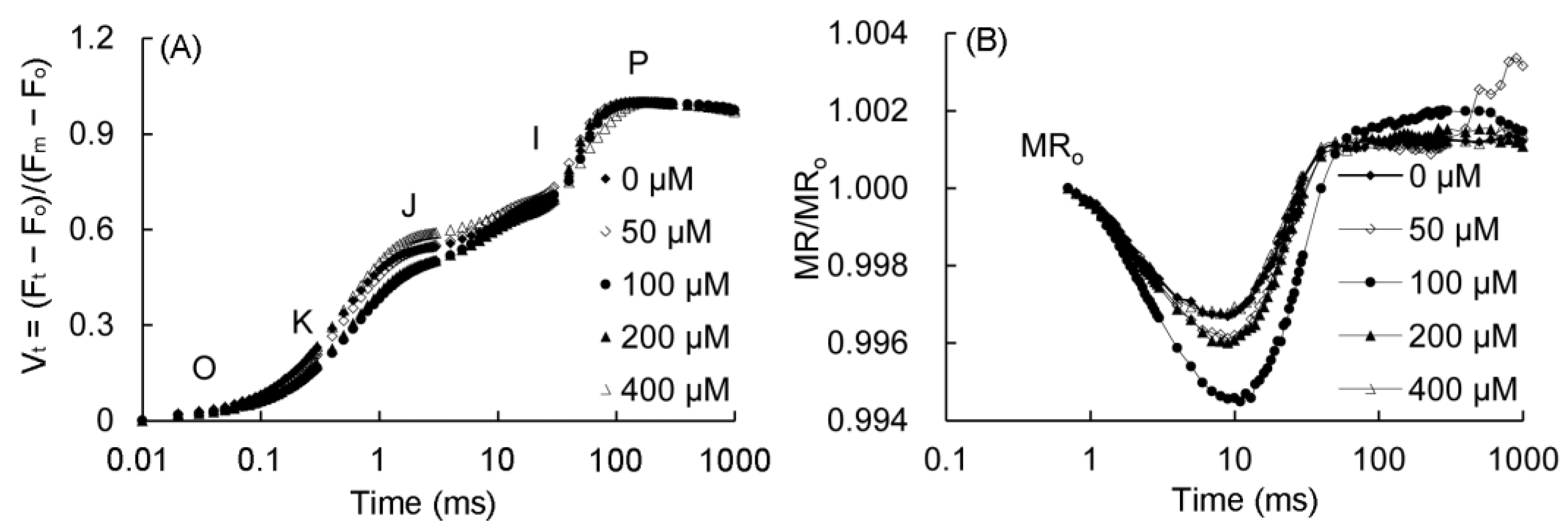
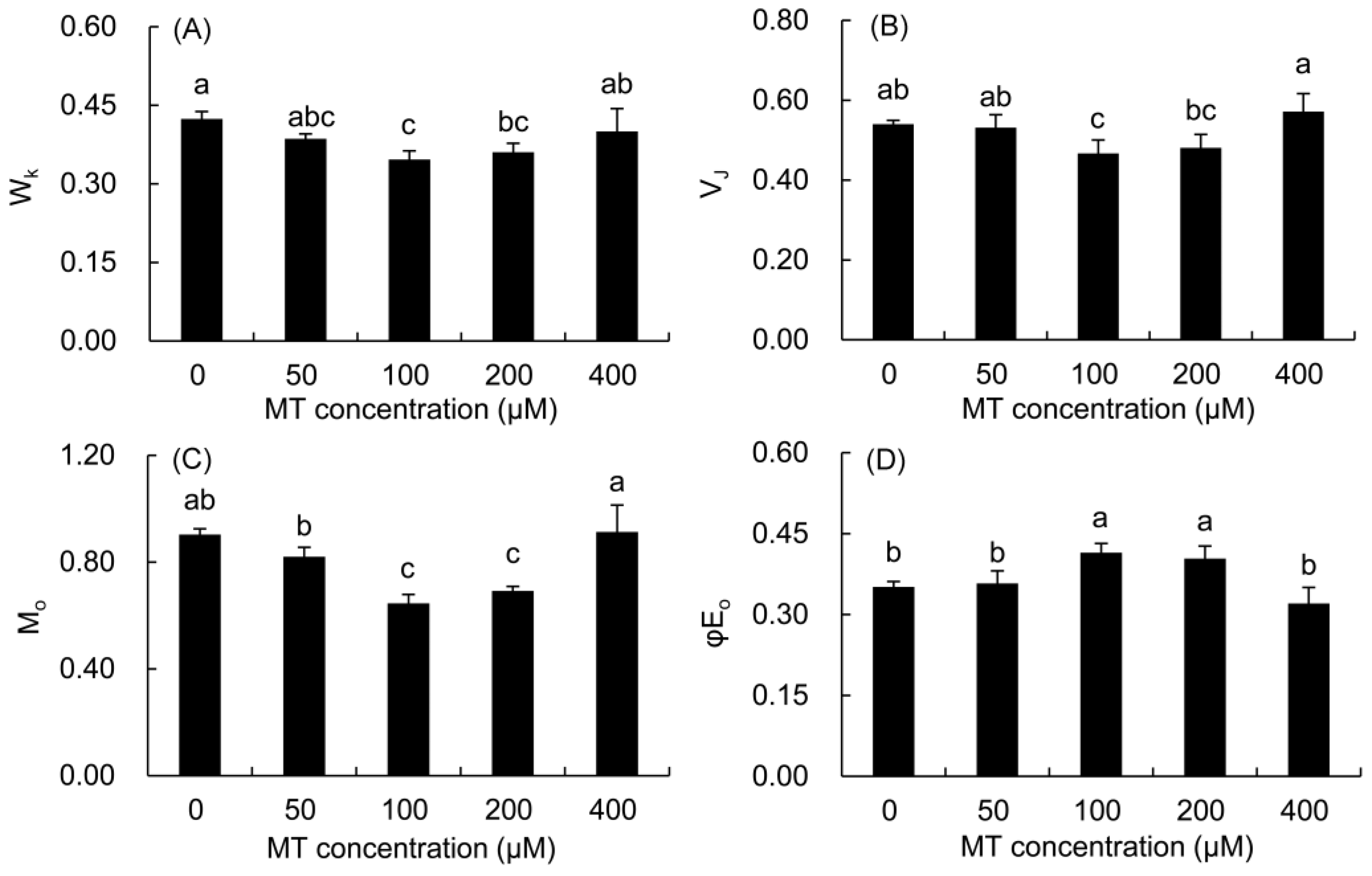


| MT (μM) | Root Length (cm) | Root Surface Area (cm2) | Root Volume (cm3) | The Number of Root Tip | Branch Number |
|---|---|---|---|---|---|
| 0 | 628.52 ± 6.28 d | 71.08 ± 11.93 d | 0.54 ± 0.03 c | 1185.67 ± 101.16 d | 1703.00 ± 64.09 c |
| 50 | 791.76 ± 21.14 c | 89.79 ± 0.94 bc | 0.81 ± 0.02 bc | 1594.67 ± 41.48 b | 2533.67 ± 63.00 a |
| 100 | 982.88 ± 43.78 a | 119.08 ± 4.83 a | 1.15 ± 0.04 a | 1989.00 ± 86.85 a | 2662.00 ± 127.47 a |
| 200 | 927.60 ± 2.77 b | 100.60 ± 0.61 b | 0.87 ± 0.02 b | 1344.00 ± 32.60 c | 2331.67 ± 20.58 b |
| 400 | 603.97 ± 19.48 d | 79.19 ± 3.77 cd | 0.83 ± 0.05 bc | 978.00 ± 13.08 e | 1396.67 ± 100.78 d |
| Parameter | 0 | 50 | 100 | 200 | 400 |
|---|---|---|---|---|---|
| ABS/RC | 1.88 ± 0.09 a | 1.69 ± 0.07 ab | 1.49 ± 0.12 c | 1.55 ± 0.08 c | 1.78 ± 0.20 a |
| DI0/RC | 0.47 ± 0.04 a | 0.40 ± 0.04 ab | 0.33 ± 0.06 c | 0.34 ± 0.03 c | 0.45 ± 0.06 a |
| Tr0/RC | 1.41 ± 0.05 a | 1.29 ± 0.03 abc | 1.15 ± 0.06 c | 1.20 ± 0.06 bc | 1.33 ± 0.15 ab |
| ET0/RC | 0.66 ± 0.03 a | 0.60 ± 0.05 a | 0.62 ± 0.06 a | 0.63 ± 0.07 a | 0.57 ± 0.10 a |
| RC/CSm | 10875.49 ± 613.14 c | 14115.10 ± 479.54 b | 16826.63 ± 2153.49 a | 15545.80 ± 525.87 ab | 11392.45 ± 1171.21 c |
| ABS/CSm | 24516.67 ± 284.63 b | 28553.33 ± 1521.33 a | 29790.67 ± 1597.43 a | 28850.67 ± 2260.85 a | 24189.00 ± 502.50 b |
| DI0/CSm | 6091.00 ± 171.47 a | 6755.67 ± 644.11 a | 6572.67 ± 408.29 a | 6417.00 ± 628.87 a | 6085.33 ± 178.07 a |
| Tr0/CSm | 18425.67 ± 456.11 b | 21797.67 ± 1035.44 a | 23218.00 ± 1910.84 a | 22433.67 ± 1685.98 a | 18103.67 ± 556.01 b |
| ET0/CSm | 8614.67 ± 132.21 cd | 10234.33 ± 1200.04 bc | 12352.67 ± 826.32 a | 11677.67 ± 1578.10 ab | 7743.67 ± 661.03 d |
| MT (μM) | Total Flavonoids | Total Phenols | Caffeic Acid | Ferulic Acid | Rosmarinic Acid | Hyperoside |
|---|---|---|---|---|---|---|
| 0 | 80.53 ± 1.02 d | 18.54 ± 0.73 e | 0.17 ± 0.00 c | 0.31 ± 0.00 b | 5.65 ± 0.07 b | 0.45 ± 0.02 c |
| 50 | 85.92 ± 0.59 c | 19.96 ± 0.74 d | 0.18 ± 0.01 b | 0.32 ± 0.01 b | 6.11 ± 0.09 a | 0.52 ± 0.02 b |
| 100 | 100.56 ± 1.33 a | 32.02 ± 0.56 a | 0.21 ± 0.00 a | 0.35 ± 0.00 a | 6.51 ± 0.36 a | 0.64 ± 0.03 a |
| 200 | 91.74 ± 1.41 b | 25.83 ± 0.41 b | 0.22 ± 0.00 a | 0.35 ± 0.01 a | 6.21 ± 0.10 a | 0.54 ± 0.03 b |
| 400 | 86.80 ± 0.89 c | 22.07 ± 0.81 c | 0.19 ± 0.01 b | 0.32 ± 0.01 b | 5.42 ± 0.30 b | 0.53 ± 0.02 b |
| Fluorescence Parameters | Description |
|---|---|
| WK = (FK − F0)/(FJ − F0) | Normalized relative variable fluorescence |
| VJ = (FJ − F0)/(Fm − F0) | Relative variable fluorescence intensity at the J step |
| M0 = 4 (F300μs − F0)/(Fm − F0) | Initial slope of the relative variable fluorescence of the relative rate at which QA is reduced |
| φE0 = ET0/ABS = [1− (F0/Fm)]ψ0 | Quantum yield for electron transport |
| ABS/RC = M0 (1/VJ) (1/φP0) | Absorption flux per reaction center |
| TR0/RC = M0(1/VJ) | Trapped energy flux per RC |
| ET0/RC = M0 (1/VJ) ψE0 | Electron transport flux per RC |
| DI0/RC = (ABS/RC) − (TR0/RC) | Dissipated energy flux per RC |
| RC/CSm = φP0 (VJ/M0) (ABS/CSm) | Density of RCs per excited cross section (CS) |
| ABS/CSm ≈ Fm | Absorbed energy flux per CS |
| TR0/CSm = φP0(ABS/CSm) | Trapped energy flux per CS |
| ET0/CSm = φE0(ABS/CSm) | Electron transport flux per CS |
| DI0/CSm = ABS/CSm-TR0/CSm | Dissipated energy flux per CS |
| Fv/Fm | Maximal quantum yield of PSII photochemistry |
| PIABS = (RC/ABS) [φP0/(1 − φP0)][ψ0/(1 − ψ0)] | Performance index on absorption basis |
Disclaimer/Publisher’s Note: The statements, opinions and data contained in all publications are solely those of the individual author(s) and contributor(s) and not of MDPI and/or the editor(s). MDPI and/or the editor(s) disclaim responsibility for any injury to people or property resulting from any ideas, methods, instructions or products referred to in the content. |
© 2023 by the authors. Licensee MDPI, Basel, Switzerland. This article is an open access article distributed under the terms and conditions of the Creative Commons Attribution (CC BY) license (https://creativecommons.org/licenses/by/4.0/).
Share and Cite
Chang, Q.; Zhang, L.; Chen, S.; Gong, M.; Liu, L.; Hou, X.; Mi, Y.; Wang, X.; Wang, J.; Zhang, Y.; et al. Exogenous Melatonin Enhances the Yield and Secondary Metabolite Contents of Prunella vulgaris by Modulating Antioxidant System, Root Architecture and Photosynthetic Capacity. Plants 2023, 12, 1129. https://doi.org/10.3390/plants12051129
Chang Q, Zhang L, Chen S, Gong M, Liu L, Hou X, Mi Y, Wang X, Wang J, Zhang Y, et al. Exogenous Melatonin Enhances the Yield and Secondary Metabolite Contents of Prunella vulgaris by Modulating Antioxidant System, Root Architecture and Photosynthetic Capacity. Plants. 2023; 12(5):1129. https://doi.org/10.3390/plants12051129
Chicago/Turabian StyleChang, Qingshan, Lixia Zhang, Shuangchen Chen, Minggui Gong, Longchang Liu, Xiaogai Hou, Yinfa Mi, Xiaohui Wang, Jianzhang Wang, Yue Zhang, and et al. 2023. "Exogenous Melatonin Enhances the Yield and Secondary Metabolite Contents of Prunella vulgaris by Modulating Antioxidant System, Root Architecture and Photosynthetic Capacity" Plants 12, no. 5: 1129. https://doi.org/10.3390/plants12051129
APA StyleChang, Q., Zhang, L., Chen, S., Gong, M., Liu, L., Hou, X., Mi, Y., Wang, X., Wang, J., Zhang, Y., & Sun, Y. (2023). Exogenous Melatonin Enhances the Yield and Secondary Metabolite Contents of Prunella vulgaris by Modulating Antioxidant System, Root Architecture and Photosynthetic Capacity. Plants, 12(5), 1129. https://doi.org/10.3390/plants12051129





